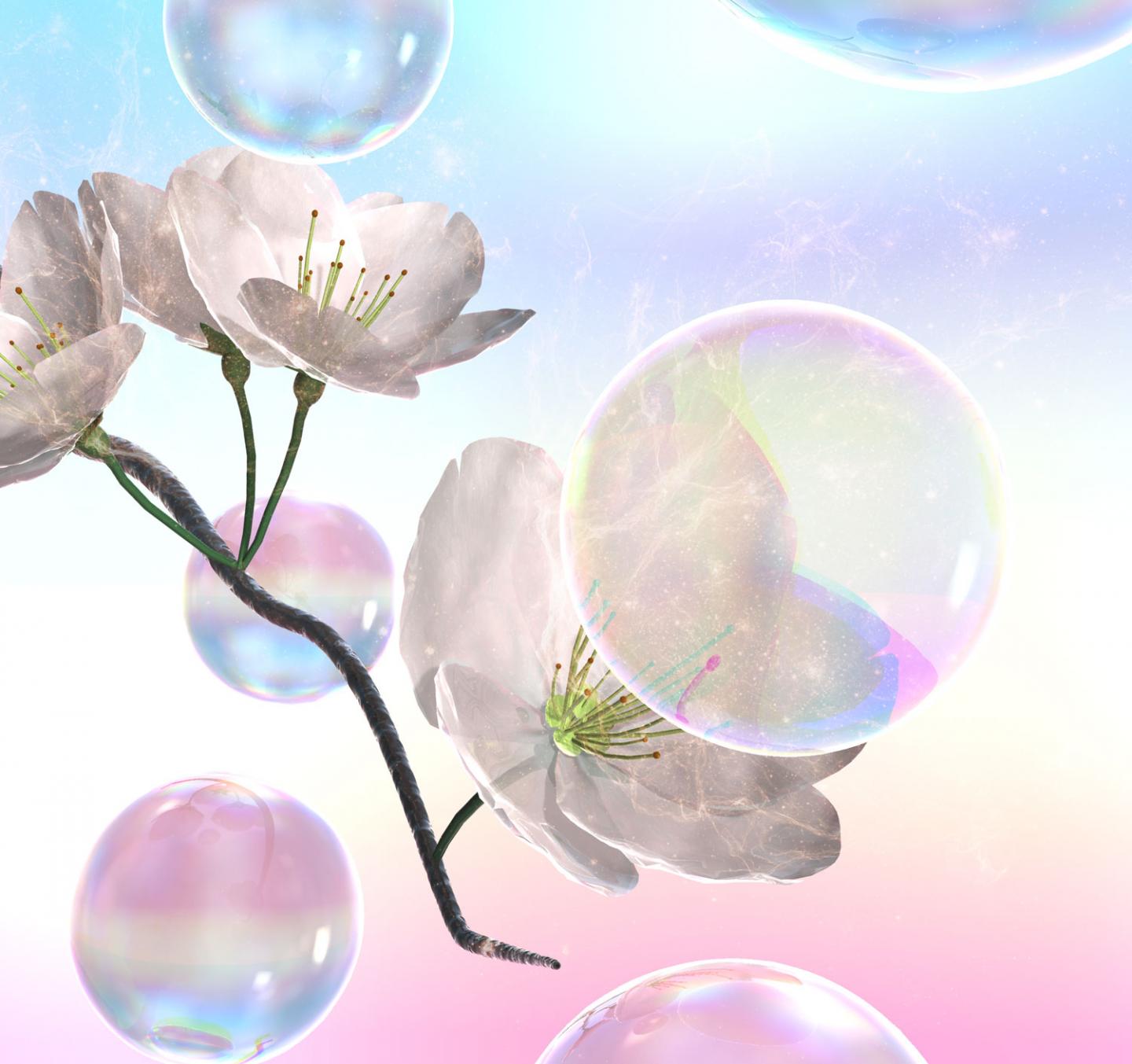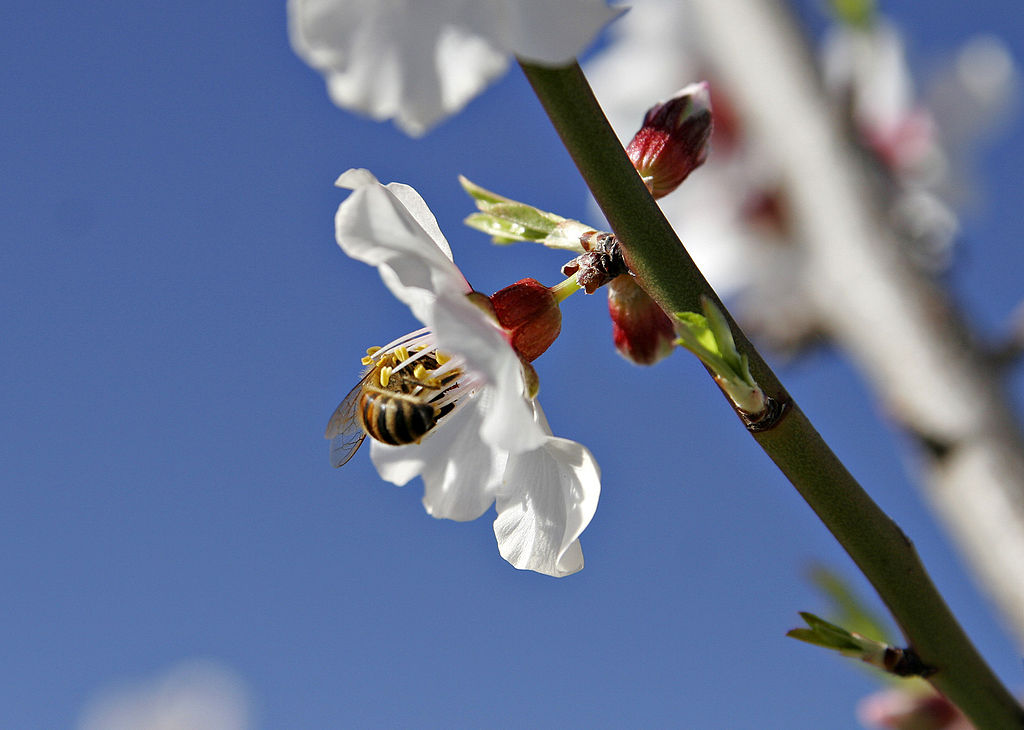- Ninety percent of flowering plants require the help of animal pollinators to reproduce, including most of the food crops we eat.
- But massive declines in the populations of bees, the most efficient pollinators around, and the rising cost to farmers of renting them to pollinate their crops, has spurred the growth of the artificial pollination industry.
- The technologies being tested in this field include the delivery of pollen by drones and by laser-guided vehicles and even dispersal via soap bubbles.
- Proponents of artificial pollination say it can both fill the gap left by the declining number of natural pollinators and help in the conservation of these species; but others say there may not be a need for this technology if there was a greater focus on conservation.
In an episode of the Netflix dystopian sci-fi show “Black Mirror,” artificial bees have been deployed to pollinate the world’s plants after a massive pollinator extinction. A great idea, until [SPOILER ALERT] the robo-bees are programmed for murder.
We are a long way from launching fake bees into the wild, experts say, but global pollinator declines are not science fiction. Artificial pollination is a real industry, with a burgeoning edge of innovation. One recently developed technique employs a more whimsical approach to pollination: bubbles.
A group of researchers from the Japan Advanced Institute of Science and Technology (JAIST) have published a study in iScience suggesting that soap bubbles could be used as a low-tech method of artificial pollination.

“It sounds somewhat like fantasy, but the functional soap bubble allows effective pollination,” said senior author Eijiro Miyako, an associate professor in the School of Materials Science at JAIST.
In the past, Miyako’s research group used tiny drones (2 centimeters, or 0.8 inches) with a patch of pollen-laden horse hairs to pollinate flowers. But the approach lacked finesse, with the drones crashing into and sometimes damaging the flowers.
Artificial pollinator in action. Video from Chechetka et al 2017.
While trying to refine the pollination problem, Miyako spent the day in a park with his son blowing bubbles. A bubble landed on the child’s cheek and Miyako was struck with an idea: that the delicate hovering sphere may be just the tool for the job.
The research team confirmed that bubbles indeed could carry pollen, and then set to work formulating the ideal soap recipe (a commonly used cosmetic soap, .04% lauramidopropyl betain, plus calcium and ions to support germination, it turns out). The team filled bubble guns with the pollen-bubble solution and blasted some pear trees. The bubble-pollinated pear trees produced viable fruits, demonstrating that the method worked.
For their final test, the researchers loaded the pollen-bubble solution into an autonomous, GPS-controlled drone. From a height of 2 meters (6 feet) and moving at 2 meters per second, the drone targeted fake lilies with 90% accuracy.
Video courtesy of Eijiro Miyako.
The problem with the bubble technique, however, is that it only works in ideal weather conditions and, even then, many of the bubbles are wasted in the wind. So, the process needs work before it could be commercialized.
Other methods of artificial pollination, however, are already on the market, and the industry is growing. Almonds, cherries, kiwis, pears and pumpkins are just a few of the species pollinated artificially in countries such as Australia, Israel, the U.S., and New Zealand.
One artificial pollination company based in Israel, Edete Precision Technologies for Agriculture (Edete), uses lasers in its method. Special machines separate pollen from flowers, and the pollen is stored for up to 18 months. When the time is right for pollination, specially equipped vehicles drive down orchard rows gently blowing out the pollen, which is given an electrostatic charge to keep the individual grains from sticking together. The vehicles use lidar sensors (a radar-like laser technology) for precision, staying within 10 cm (4 in) of the trees’ contours.

Pollination occurs when a pollen grain lands on the sticky stigma of the plant. A pollen tube grows down into the ovary of the plant, transferring genetic material. The ovary then grows into a seed-bearing fruit. Some plants can self-pollinate, but many, including most of the food we eat, need to be cross-pollinated with pollen from a different individual to produce mature and healthy fruit.
Pollen is either carried by the wind, water, or an animal pollinator. An estimated 90% of all flowering plants require animal help for reproduction, and there are something to the tune of 200,000 pollinator species to do the job.
Honeybees, native to Europe and Asia, are just one group of about 20,000 bee species worldwide. Some live in the ground and others on high, cool mountaintops. Some are social, like honeybees. Some are yellow and fuzzy while others are metallic blue, green or black.
“Bees are one of the more efficient pollinators out there,” Paul Caradonna, a conservation scientist at the Chicago Botanic Garden who studies the population and community ecology of plants and pollinators, told Mongabay. “Once you start looking into what all these bees look like there’s a stunning diversity.”

So why are scientists going to the trouble of inventing special bubbles and laser machines to pollinate crops when bees have evolved over millions of years to do this work in an efficient, precise and cost-effective way?
The first reason, is that bees are disappearing. Scientists have reported pollinator declines and in two areas. One is a decline in honeybees, via colony collapse disorder, and the other is the more general decline of native pollinators. Habitat loss and fragmentation; pathogens and disease; pesticides, insecticides such as the neonicotinoids, herbicides and fungicides used in agriculture and landscaping; invasive species; climate change; and competition between honeybees and native bees are some of the reported causes of pollinator declines.
The second reason has to do with the business of pollination. In many cases, farmers rent honeybees to pollinate their seasonal crops. In the U.S., for instance, more than 2 million bees are shipped from all around the country to California in late winter just to pollinate almond trees.
As honeybee populations dwindle, renting them has become more expensive. Currently, almond pollination requires around two beehives per acre, at a cost of $200-$240 per hive. Costs are expected to rise by as much as 20% next year, according to Edete. In China, farmers have found hand pollination to be cheaper than renting hives in some apple orchards.

This bee rental business is also quite stressful for the bees. Let’s follow a hive of rented honeybees on a pollination road trip through the U.S.: first stop, the almond farms of California.
“It’s like an ocean of almond flowers, and so they only get to eat almonds for a month or however long they’re out there,” Caradonna said in the podcast Botanical Mystery Tour. “Which is kind of like if I said ‘OK, you can eat only frozen tacos for a month.’ It would get boring after a while. It would get monotonous. And you might start to feel a little sick.”
On top of that, the bees are exposed to pesticides and a bit of the toxic arsenic present in almond pollen and nectar. Once the almond season ends, the bees are trucked out, in their hives, to their next monocrop gig, apples in Washington, for example, and then on to the opposite coast for pumpkins.
A single colony of bees may spend months moving from place to place. All of this stress makes the bees more susceptible to disease and parasites. In some cases, diseases can spread from honeybees to native bees.

As long as we are relying on large, monoculture agriculture to feed people, and the bee renting business is becoming less economical, artificial pollination may be here to stay. And it could even have a role to play in bee conservation, Keren Mimran, vice president of business development and marketing at Edete, told Mongabay.
“We really believe, everyone here in the company believes, that if there will be no bees, it’s going to be a catastrophe,” Mimran said. “We do believe that humanity has to do everything within its power to protect the bees.”
Artificial pollination, according to Mimran, allows beekeepers to put beehives in places where there’s healthier food for the bees, where they can forage more easily and where they can work on non-commercial plants and are less likely to spread diseases to native bees.
Others are cautious about singing the praises of artificial pollination too loudly.
“I don’t want to stifle innovation,” Caradonna said, “but what worries me is that the discussion about artificial pollination may shift our focus away from pollinator conservation … If we supported native pollinators, we may not need funky sci-fi pollination.”
Artificial pollination, Caradonna says, only really works in these homogenous, monocrop systems. When you add the complexity of a natural system, with millions of different species of plants to pollinate, the prospect becomes much more challenging. Unlike “Black Mirror,” we are a long way off from artificial pollination doing the job of our diverse, native pollinator pantheon.
Citation:
Yang, X., & Miyako, E. (2020). Soap Bubble Pollination. Iscience, 23(6), 101188. doi:10.1016/j.isci.2020.101188
Banner image of a soap bubble carrying pollen to a flower courtesy of Eijiro Miyako.
Liz Kimbrough is a staff writer for Mongabay. Find her on Twitter @lizkimbrough_
FEEDBACK: Use this form to send a message to the author of this post. If you want to post a public comment, you can do that at the bottom of the page
